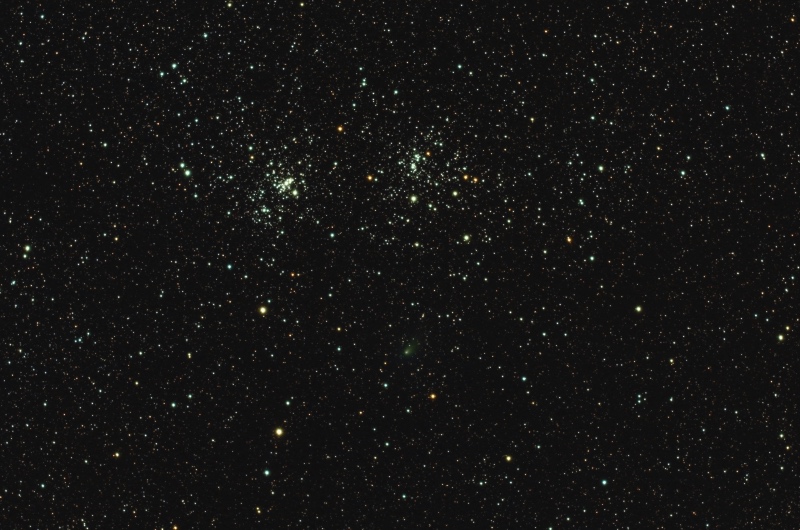
Link to a larger jpeg image: 1920 pixels wide
Comet C/2017 T2 Panstarrs near the Double Cluster
About this object
The above image is a short 35min exposure of Comet C/2017 T2 Panstarrs moving by the famous Double Cluster in Perseus on the night of 28 January 2020. The comet is fairly small, greenish and dim just below center. Click on the larger image link above to better see the comet and small tail. I had originally shot 60 1min exposures but nearly half where not usable due to dewing problems when the dew heater battery failed. The comet was moving fairly slow and was near the Double Cluster for several nights in late January.
For those interested in processing: I used PixInsight to process the image. The Weighted Batch Preprocessing Script was used to calibrate and stack the 35 images and produce a RGB image. Multiscale Linear Transform was used with a linear mask to perform some noise reduction prior the stretching. The image was then stretched to produce a non linear image. The luminance was extracted to create a star mask of the stars and comet. This mask was used with TGV De Noise to further reduce the noise in the background of the image. The mask was also used to increase the color saturation of the stars and comet.
The above image is a short 35min exposure of Comet C/2017 T2 Panstarrs moving by the famous Double Cluster in Perseus on the night of 28 January 2020. The comet is fairly small, greenish and dim just below center. Click on the larger image link above to better see the comet and small tail. I had originally shot 60 1min exposures but nearly half where not usable due to dewing problems when the dew heater battery failed. The comet was moving fairly slow and was near the Double Cluster for several nights in late January.
For those interested in processing: I used PixInsight to process the image. The Weighted Batch Preprocessing Script was used to calibrate and stack the 35 images and produce a RGB image. Multiscale Linear Transform was used with a linear mask to perform some noise reduction prior the stretching. The image was then stretched to produce a non linear image. The luminance was extracted to create a star mask of the stars and comet. This mask was used with TGV De Noise to further reduce the noise in the background of the image. The mask was also used to increase the color saturation of the stars and comet.
Image Details
- Optics : Stellarvue SV70T
- Mount: Astrotrac portable pier system
- Camera: Canon 60Da
- Filters: none
- Exposure: (35) @1min
- Camera/Mount Control: Interval timer
- Guiding: Unguided
- Processing: PixInsight 1.8,
- Location: Stark Bayou Observatory, Ocean Springs, MS
- SQM: 19.6 Bortle 5, suburban
- Date: 28 Jan 20, 0230 UTC



